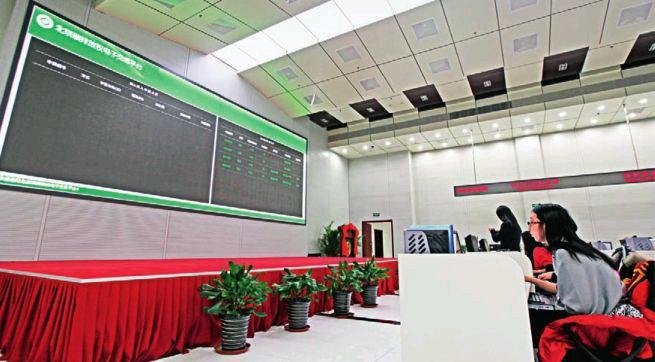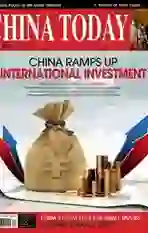Carbon Trading:Market Mechanisms to Tackle Pollution
2014-05-27BystaffreporterLI
By+staff+reporter+LIU+YI
YANSHAN Petrochemical paid a power plant RMB one million for a 20,000 ton quota of carbon dioxide emissions, on November 28, 2013. This marked the official launch of the Beijing Carbon Trading Market. Whats more, it signaled that “energy conservation and emission reduction” has moved on from being just a slogan to become a key issue, encompassing profits, cash flow and investment.
The Beijing Carbon Trading Market is one of seven pilot markets in China. In June 2013, Chinas first carbon market was officially launched in Shenzhen, followed by Shanghai, Beijing, Guangdong Province, and Tianjin – all in the last quarter of 2013. The newest two pilot markets, Hubei and Chongqing, are making intensive preparations. The five markets in operation have established registration systems and trading platforms, as well as detailed supportive regulations including accounting and reporting guidelines for greenhouse gas emissions of enterprises in major industries, thirdparty verification guidelines, and trading rules. They started a carbon-emission trading system in China from scratch.
“We will realize the goal of controlling greenhouse gas emissions through market mechanisms, allowing the market to play a decisive role in resource allocation. This will reduce the social costs of energy saving and carbon reduction, propel institutional innovation and accelerate transformation of the development mode,” Su Wei, director general of Climate Change Department in the National Development and Reform Commission (NRDC), told China Today in an interview, “It is of great significance in boosting overall reform and ecological progress.”
The Power of Markets
After conducting a survey and calculations, Yanshan Petrochemical found it could get a carbon dioxide discharge quota of about 3.91 million tons a year, which is expected to drop from 2013 to 2015 by 2 percent on a yearly basis, representing 70,000 to 80,000 tons of emissions. As a heavy industry, however, Yanshan needs to expand and transform its operation, as well as install new equipment to increase production, which would definitely result in increased energy consumption and carbon emissions.
In the new carbon trading market, rigid emission-reduction policies have turned into a market-driven system. Under this system, companies have two options: either pay for extra carbon quotas every year, or introduce energysaving technologies to reduce energy consumption.
Choosing the former involves higher and higher costs; while choosing the latter means companies would need to close down outdated production facilities and improve technologies, which would give rise to expenditures, but in the long run could increase productivity as well as gain better social benefits. After researching the carbon market system over the last couple of years, Yanshan Petrochemical took the initiative to look for “black holes” in energy consumption. It has recycled waste heat, optimized the steam system, carried out technological renovations and adopted information technologies to sharply reduce energy consumption.
“Environmental protection cannot only rely on government subsidies, or administrative commands, or fines,”said Qian Guoqiang, strategy director of Sino Carbon Innovation Investments,“We should introduce a market mechanism. Nothing but the constant power of the market will provide a fundamental solution to improving company environmental awareness.”
From as early as 2005, when he worked at the Ministry of Foreign Affairs, Qian has engaged in international negotiations on climate change and domestic policymaking. He co-founded Sino Carbon in 2010, aiming to promote low-carbon development in China. In 2013 he was elected a member of the Joint Implementation Supervisory Committee (JISC) for the United Nations Framework Convention on Climate Change. Qian has witnessed the entire process of Chinas construction of carbon trading markets in the last decade.
He observes that some companies are shortsighted, as they see the carbon market as a burden, rather than actively adapting to the new trend and rules. In reality, emissions reduction is directly related to a companys efficiency and innovation capacity. “If others use only three units of resources to produce an item and you use five,” Qian said, “without competitive advantage, the market will eliminate you.”
Thus far, the EU, New Zealand, Australia, Japan and California in the U.S.A. have adopted the carbon market system. Qian believes that carbon emissions will become a key product data in the future, and once foreign markets have a relatively mature mechanism they may even set up trade barriers in the name of carbon emissions.
How the Market Operates
The over 490 companies participating in carbon trading in the Beijing market account for about 40 percent of total carbon dioxide emissions in the capital. According to Beijing regulations, if a companys direct and indirect carbon dioxide emissions exceed 10,000 tons a year, it must meet its obligations to control carbon emissions. These companies, referred to as regulated organizations, comprise the main body for carbon emissions trading. Those with complex energy consumption of over 2,000 tons of standard coal can voluntarily participate in the market, and are known as voluntary organizations.
The whole process of carbon emission trading includes five steps – emissions data reporting, third-party verification, quota allocation, trading, and implementation. Every year, a company must report its emissions data of the previous year to the Beijing Municipal Commission of Development and Reform, and receive independent verification from third-party organizations. The commission then allocates an annual quota for carbon emissions. After receiving its electronic-certificate quota, the company may buy or sell quotas in the market, with the quota cleared every year.
“Our carbon trading center is responsible for the ‘trading step,” said Wang Yang, director of the Carbon Trading Center of the Beijing Environment Exchange (CBEEX). In the hall of CBEEX, successful trading information is repeatedly displayed on a giant screen. The trading parties, via a computer installed with a digital trading platform system, can directly trade by entering purchase prices and emission quantities, all accomplished quite conveniently.
This handy trading process is backed with a precise but bulky information system. To build a carbon market, most important is genuine, accurate and comprehensive data on carbon emission. The NDRC told China Today that the preparation for all the five pilot markets took several years. On the one hand, they had to carefully calculate the total control targets for greenhouse gases by 2015; on the other hand, they called for bidding to select independent third-party organizations to conduct comprehensive and in-depth examinations on trading companies, and collected a large amount of reliable firsthand basic data. The unified standards used in data collection and emissions calculation buttress companies trust in the carbon transaction, so they more readily accept the data.
Another key link is quota allocation, which not only relates to company costs of production, but also to the level of the carbon price. Thus far, there are two popular allocation methods used across the world – benchmarking and grandfathering. The benchmarking quotas are allocated according to the benchmark emissions of an industry, while the grandfathering allocation is based on historical level of emissions.
The five pilot markets have adopted the two methods and demonstrate much flexibility in operation.
For example, Shanghai adopts benchmarking for electricity, aviation, airport and harbor companies, and grandfathering for other industries and public construction. Beijing uses grandfathering for existing facilities, namely their average annual emissions from 2009 to 2012, while benchmarking is used for new projects. “If a company performs well in emission reduction, the quota will be surplus, and they could sell it in the market and acquire capital.” Wang said. During the annual clearance, if a company is found to be surpassing its quota and not purchasing new quotas, it would probably be fined three to five times the average price in the carbon market.
In the last four months, Wang discovered a phenomenon: the more dynamic aspect of the market is the voluntary organizations, which benefit from price fluctuations. Qian Guoqiang believes that carbon trading has a financial nature, and moderate speculation is normal only if the supervision works effectively. “One of the benefits around speculation lies in that it can introduce large amounts of money into the market, while reducing risk by spreading one persons risk to every stakeholder,”he explained. “If the investors and companies can make money in the carbon market, they will get ahead. It is such an environment that the carbon trading market aims to create.”
National Carbon Market Anticipated
Currently, the five pilot markets in operation are independent, with their own registration systems and trading platforms. However, to allow market mechanisms to play a bigger role, they must break out of their closed systems and establish a unified, open national market. Su Wei told China Today that the central government is studying the experience of the seven pilot markets to establish a national market, striving for completion in the 13th Five-year Plan period (2016-2020).
For policy and technological reasons, it is more practical to construct a new national market than to promote the mode of one pilot market or to increase the number of pilot markets. The seven pilot markets have various regional characteristics, such as the financial center of Shanghai, industrialized Guangdong and Shenzhen, and less-developed Hubei and Chongqing. With different economic development levels, industrial distribution and company scales, these pilot markets had to fully consider local conditions during preparations. They have shown innovativeness and flexibility when establishing trading mechanisms, rules and accounting systems, which provide useful experiences, but also demonstrate many differences between their systems.
For example, concerning the threshold for regulated companies, Shenzhen set a standard at 5,000 tons of carbon emissions a year, and Beijing, 100,000 tons; while Shanghai and Guangdong first selected several industries and then set standards. The detailed trading rules also differ. In Shenzhen and Tianjin, after verification, individuals are allowed to participate in trade; while in Guangdong and Shanghai only regulated companies are allowed to trade. In addition, in Beijing and Tianjin, besides online trading, offline negotiation and trading are also permitted.
Therefore, Su Wei says, it will be difficult to interconnect different markets in the short term, owing to complicated issues involving policy and technology; and there is no point in increasing pilot markets, as it would create more small independent markets, and waste resources.
Thus far, the NDRC has invited experts to research the total control targets of Chinas carbon trading, and published accounting and reporting guidelines for key industries greenhouse gases. It plans to strengthen basic data collection, and implement a greenhouse gas emission reporting system for key companies nationwide, so as to confirm the scope of regulated companies, and formulate a reasonable quota allocation plan. In addition, the NDRC will establish a unified registration system and third-party verification system in the country, draw up supervision rules and figure out riskprevention methods. Meanwhile, the commission is also researching the feasibility of carbon futures, and pondering over the sustainable and healthy development of the market.
“A large unified market will inject new vitality into carbon trading,” Wang Yang said. “Its no problem to operate under the new standards. Beijing will adapt better than other regions as we have accumulated several years of experience.” In January 2014, the CBEEX, collaborating with carbon trading organizations in 15 provinces and cities, launched the China Environment Trading Organization Cooperation Alliance, to strengthen exchange and cooperation among markets. Carbon trading represents a vast, new market. Practice and cumulative experience are needed to safeguard the sound development of the market.
